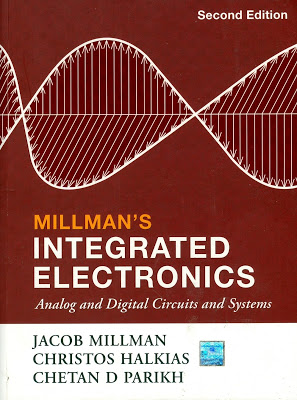Electronic Devices and Circuits
An electronic component is any physical entity in an electronic system used to affect the electrons or their associated fields in a manner consistent with the intended function of the electronic system. Components are generally intended to be connected together, usually by being soldered to a printed circuit board (PCB), to create an electronic circuit with a particular function (for example an amplifier, radio receiver, or oscillator). Components may be packaged singly, or in more complex groups as integrated circuits. Some common electronic components are capacitors, inductors, resistors, diodes, transistors, etc. Components are often categorized as active (e.g. transistors and thyristors) or passive (e.g. resistors, diodes, inductors and capacitors).
A list of all the reference books for Electronics Devices and Circuits (Solid State Devices), These books are available for download
Circuits and components can be divided into two groups: analog and digital. A particular device may consist of circuitry that has one or the other or a mix of the two types.
Digital circuits are electric circuits based on a number of discrete
voltage levels. Digital circuits are the most common physical
representation of Boolean algebra,
and are the basis of all digital computers. To most engineers, the
terms “digital circuit”, “digital system” and “logic” are
interchangeable in the context of digital circuits. Most digital
circuits use a binary system with two voltage levels labeled “0” and
“1”. Often logic “0” will be a lower voltage and referred to as “Low”
while logic “1” is referred to as “High”. However, some systems use the
reverse definition (“0” is “High”) or are current based. Quite often the
logic designer may reverse these definitions from one circuit to the
next as he sees fit to facilitate his design. The definition of the
levels as “0” or “1” is arbitrary.
Heat generated by electronic circuitry must be dissipated to prevent immediate failure and improve long term reliability. It is mostly achieved by passive conduction/convection. Means to achieve greater dissipation include heat sinks and fans for air cooling, and other forms of computer cooling such as water cooling. These techniques use convection, conduction, and radiation of heat energy.
Read about How to face a HR interview
Text Books
1. Donald Neamaen, “Electronic Circuit Analysis and Design”, 3rd Edition, TMH.
2. Millman, Halkias, “Integrated Electronics- Analog and Digital Circuits and Systems”, TMH.

Reference Books
1. David A.Bell, “Electronic Devices and Circuits”, 5th Edition, Oxford press
2. Boylstad,Nashlesky, “Electronic Devices and Circuits Theory”,9th Edition, PHI, 2006.
3. Pucknell, Kamran, “Basic VLSI Design”, 3rd Edition, PHI, 1994.
4. Sedra/ Smith, “Microelectronics Circuits, 5th Edition, Oxford, 1999.
You can purchase these books online, or you can download them in pdf format just google it with the name. Electronic components referred by the book can also be ordered online.
Here are some other programs of DSP Matlab
Discrete fourier transform
Modulo operator
Linear Convolution





